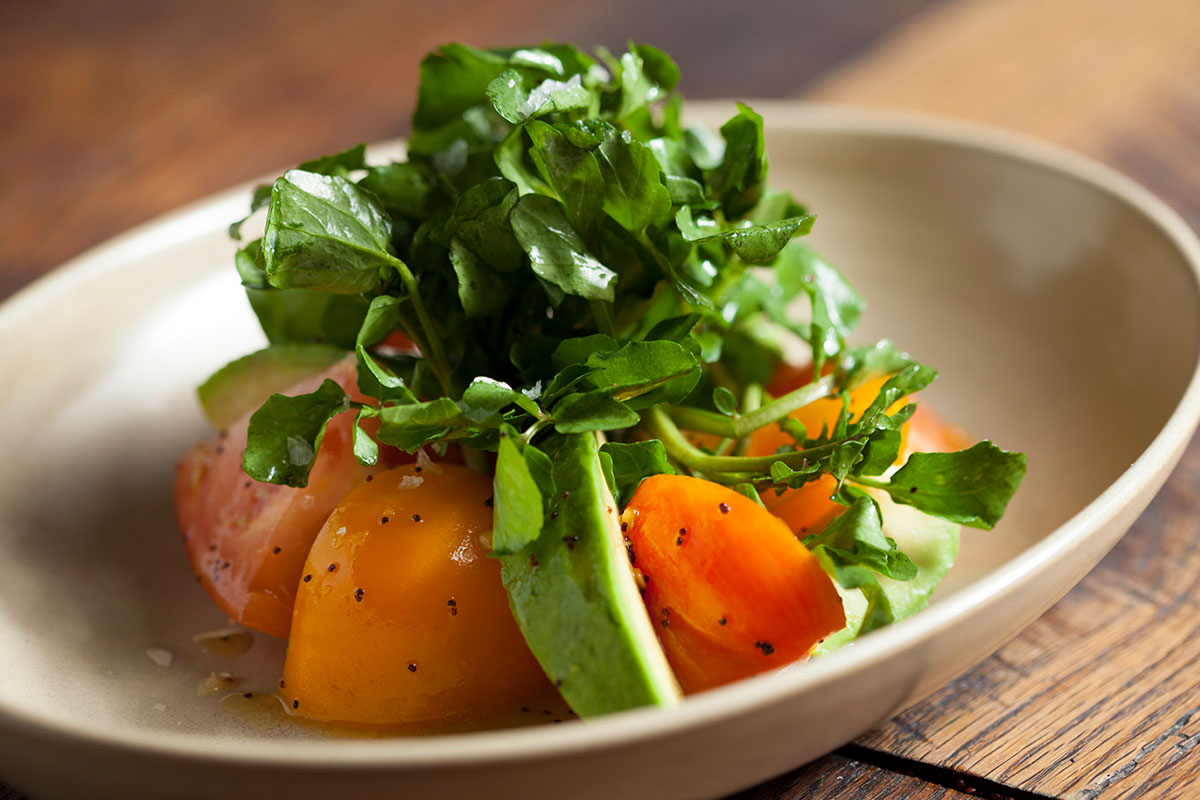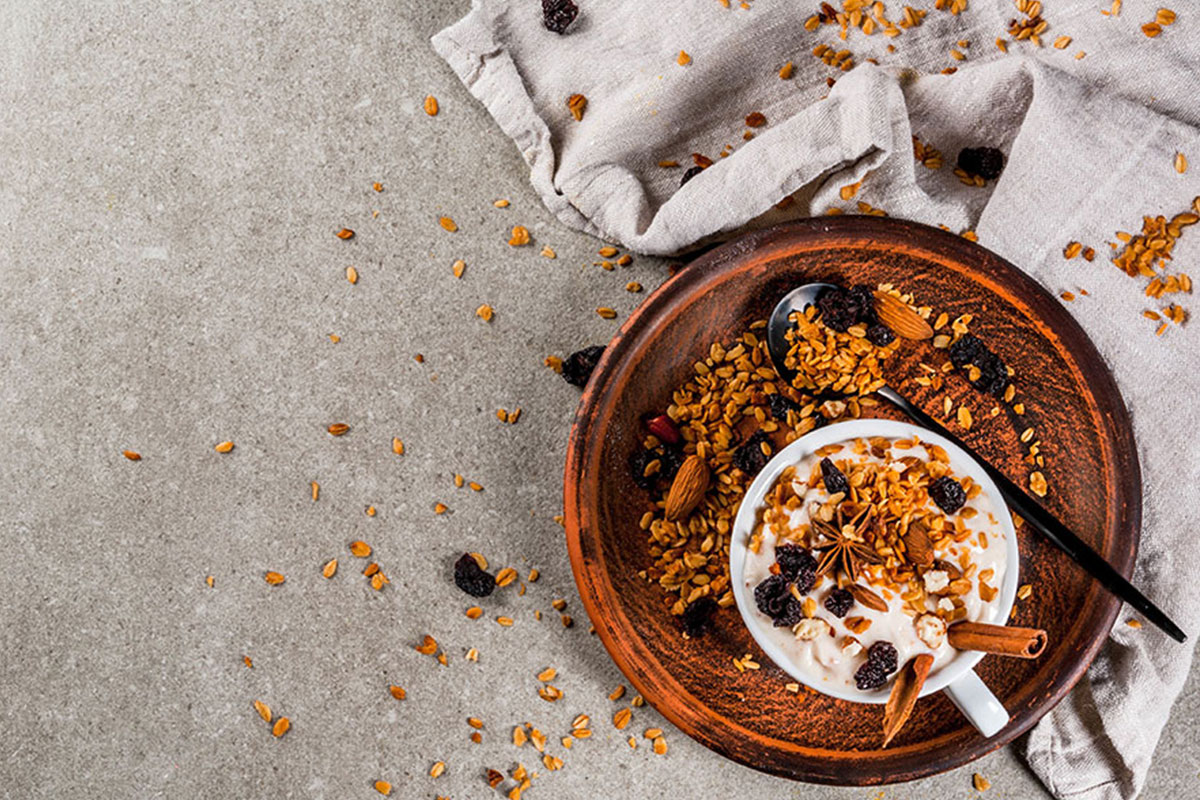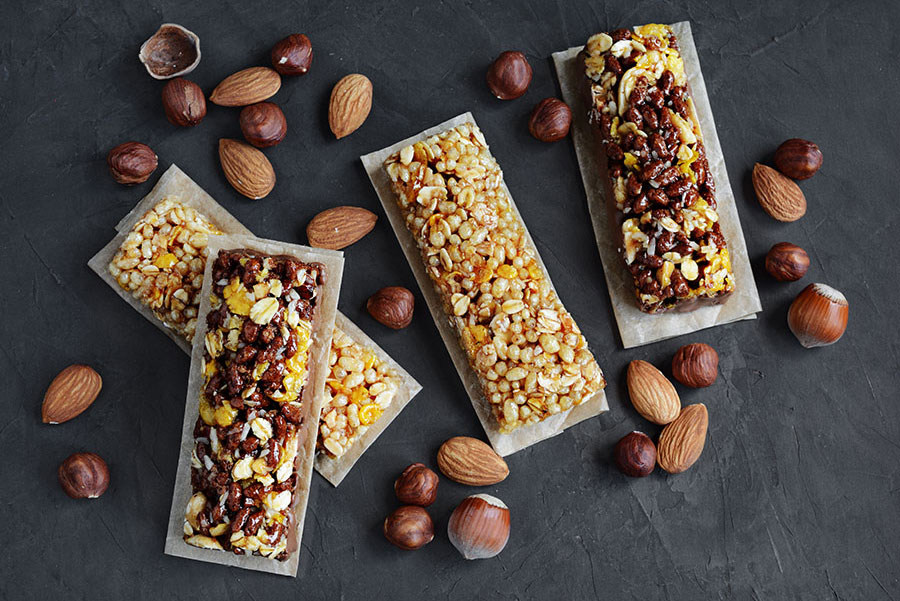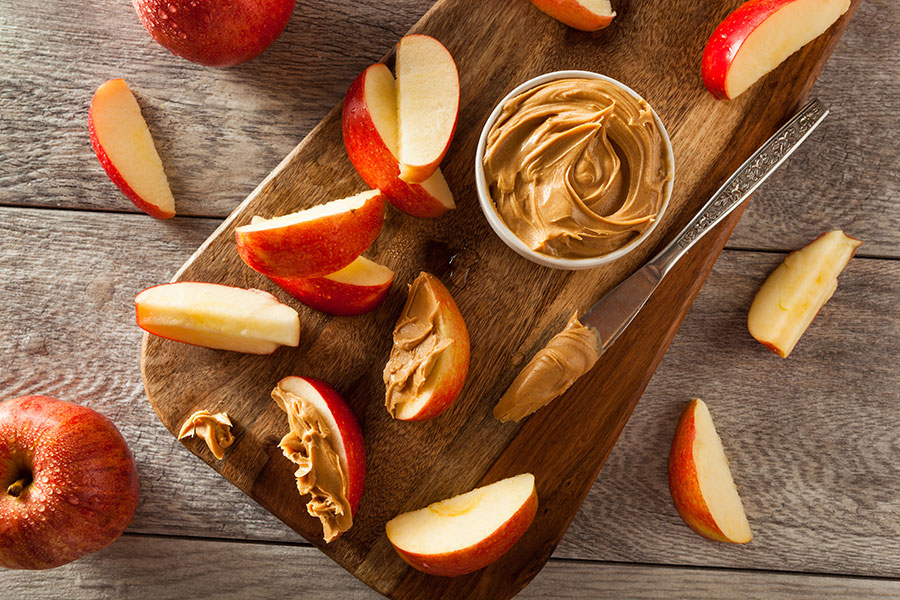Tomato Avocado Salad with Poppy Seed Dressing from Water Grill
Chef Brian Okada of Water Grill shares his recipe for Tomato Avocado Salad with a light Poppy Seed Dressing. It's quick, it's easy, healthy and tasty!

As children, we don’t have much choice in the foods we are provided and the habits we are taught to cultivate. This is why changing our diet is so difficult; you have to retrain your taste buds. Fortunately, this is completely doable, even if it’s a bit difficult.
We’re taking things step-by-step to help you transition to a healthier style of eating. Read on for your complete guide on how to love the taste of health foods!
01.
Before you can build new habits, you need to look at your current eating patterns. Make a food log and, over the course of a week, write down everything you eat and when you eat it. If you like, color-code your information so you know which foods were meals, which were snacks, and maybe even which ones you ate when you knew you weren’t hungry.
02.
The reason we’re going through this step first is because we’re planning on introducing new foods. To avoid adding additional calories to your day, it’s probably a good idea to replace calories that you would have typically eaten anyway.
03.
There are a lot of options here and many of them are shunned for their acidic, bitter, pungent, or seemingly tasteless profiles. Examples include: Lemon, vinegar, kale, spinach, arugula, quinoa, plain yogurt, and fatty fish.
04.
Instead of forcing yourself through a plateful of kale, start training your taste buds to like the type of flavors in your chosen foods. For example, introduce more sour, bitter, and umami flavors into your diet. If you’re unfamiliar with umami, it’s the distinct taste you can find in foods like seaweed, miso, salmon, and hard cheeses like parmesan.1



Start adding sour foods that you do enjoy to your diet.
If you want to eventually enjoy vinaigrette on your salad but you don’t like the acidity and sourness of it, regularly eating sour foods that you do like can build your tolerance for sour flavors. Here is a list of nutritious sour foods: 2,3



Following the same principle as before, start incorporating bitter flavors that you do enjoy.
Here is a list of nutritious bitter foods.3,4 Choose one you’re comfortable with and slowly push the boundaries of what you’d normally eat until you arrive at a tolerance (and hopefully enjoyment) for the level of bitterness you want to achieve.



Start Incorporating umami flavors
The umami flavor comes from a compound extracted from dry kelp.3 It is this flavor, and others like it, that have the savory taste you’ll find in many Oriental dishes. Here is a list of nutritious umami foods5 that you can add to your diet.
Another tactic is to learn to make your favorite dishes in ways that are healthier. Slowly substitute an ingredient or two, each time you make it, until you’ve crafted a healthier version of the same recipe! Here are some substitutions, straight from the Mayo Clinic, for commonly used recipe ingredients. For the full list, visit their post on Healthy recipes: A guide to ingredient substitutions.
|
Original Ingredient |
Substitution |
|
Breadcrumbs |
Rolled Oats/Crushed Bran Cereal |
|
Butter/Margarine/Shortening/Oil |
Applesauce/Prune Puree |
|
White Rice |
Brown Rice/Bulgur/Pearl Barley/Wild Rice |
|
Whole Milk |
Reduced Fat Milk/Fat Free Milk |
|
Ground Beef |
Lean Ground Beef/Ground Chicken/Ground Turkey |
Ultimately, you have to change your mind-set before you can change your taste buds. Food is what fuels your body. The more nutritious that fuel is, the better your body will feel and the more easily it can process what you put in. Gradually learning to enjoy flavors found in health foods is the key. So, take it slow, and work your way to a more nutritious lifestyle.
For help creating a meal plan, read our registered dietitian’s post on How to Create a Meal Plan. If you need help catering to picky kids and teens, read her post on How to Get Your Kids to Eat Right. To access our monthly blog post highlights, subscribe to our newsletter today!
Sources

“Healthy and fresh food should be food that not only is good for your body, but it should also be flavorful. This salad is a great example of that. It’s made with seasonal tomatoes, field fresh watercress and ripe avocados. The dressing is light and fresh tasting and ties it all together.”
Water Grill is located at 615 J Street, San Diego, CA 92101. Open Sunday-Thursday 11:30am-11pm, and Friday-Saturday 11:30am-Midnight. For the menu and additional details, please visit http://www.watergrill.com/.





Photo Credit: Courtesy of King’s Seafood Company
For the Tomato Avocado Salad
For the Poppy Seed Dressing
Step 1:
Step 2:
Featured Recipes
Chef Brian Okada of Water Grill shares his recipe for Tomato Avocado Salad with a light Poppy Seed Dressing. It's quick, it's easy, healthy and tasty!
Let's go back to the basics, at True Food Kitchen guests are given real food, with real fresh ingredients. Nothing here but true foods, for a healthy life.

If you ask any fitness maven walking (or more likely running) down the street, they will immediately condemn the idea of “fasted cardio”, referring to the method of not eating before a workout in order to burn and lose body fat. They will tell you it is ineffective and potentially dangerous, and then probably start describing the simply seasoned chicken breast or protein-packed omelet (depending on what time of the day it is) they chowed down before they laced up their sneakers.
In order to get the full benefits of exercise, you need a healthy and balanced diet. Whether you’re hiking outdoors or sweating it out in a spin class, the right foods before and after a workout provide you with more energy and aid your body in recovering faster.
The best food pre-workout is going to be packed with carbohydrates and proteins. Carbs are your muscles’ main energy source and protein helps to improve your muscles’ growth and recovery. You want to avoid eating too much fat before a workout as that will cause you to feel more sluggish and heavy, although healthy fats like avocado have been shown to be a good source of fuel for moderate-to-low intensity workouts. Ideally, you’ll want to eat 2-3 hours before a workout, so that your body has time to digest. Good sources of protein pre-workout include:






As your pre-workout time ticks down, eating a meal that contains mainly carbs and some protein is ideal to ensure digestion. Simple carbs like bananas, dried fruit, and fruit smoothies with a dash of protein powder provide a quick energy boost for a 30-60 minute workout, whereas complex carbs are slow releasing energy sources and have a slower metabolism rate.
Sources of carbs include:
Many of these foods can double up as energy sources post- workout as well. Complex carbs and proteins are a necessary foundation as the body rebuilds itself post workout. Proteins are key to help repair and rebuild muscle tissue. It’s recommended to eat your post-workout snack/meal within 30 minutes after the treadmill slows to a stop. And of course, make sure you are replenishing fluids to further help your recovery. So, get cooking, get running, happy workout and bon appétit!
The same way you can teach your taste buds to acquire a taste for escargot, you can train them to love foods that are better for your body!
Chef Brian Okada of Water Grill shares his recipe for Tomato Avocado Salad with a light Poppy Seed Dressing. It's quick, it's easy, healthy and tasty!
Looking for the right foods to maintain a healthy and balanced diet for pre and post workout nutrition? Look no further than this list of 11 must-include foods!


Could you recommend any best practices, storage methods, perishable and non-perishable food items, protein shakes, or other helpful tips for flight attendants or airline crew who desire to eat healthily but have limited access to refrigeration or healthy food options while on 3-5 day work trips?
– Ryjean R.

The two flight attendants I asked replied that they usually bring hard boiled eggs, avocados, salsa, sealed chicken apple sausages, green smoothie singles, lots of sturdy fruits like apples and oranges, nuts and seeds, carrots, jicama, and celery sticks with almond butter. For meals: vacuum-packed brown and white rice (can be served cold with cheese cubes and peas/corn), pasta salad with diced ham, or some frozen items like homemade casseroles or chicken curries – microwave required. Having a good cooler is essential!
Also see our previous answer to another flight question – What meals can I pack that will keep for up to 5 days, and that will help me lose weight?
– Debbie J., MS, RD
This article should not replace any exercise program or restrictions, any dietary supplements or restrictions, or any other medical recommendations from your primary care physician. Before starting any exercise program or diet, make sure it is approved by your doctor.
Some questions have been edited for length and/or clarity.
 Have a nutrition question? Our registered dietitian is ready to help!
Have a nutrition question? Our registered dietitian is ready to help!
Email nutrition@lafitness.com or submit your question below and it may be featured in an upcoming article!
The same way you can teach your taste buds to acquire a taste for escargot, you can train them to love foods that are better for your body!
Chef Brian Okada of Water Grill shares his recipe for Tomato Avocado Salad with a light Poppy Seed Dressing. It's quick, it's easy, healthy and tasty!
Looking for the right foods to maintain a healthy and balanced diet for pre and post workout nutrition? Look no further than this list of 11 must-include foods!


What are the best foods for muscle and ligament recovery?
– Craig K.

If you’re talking about short-term daily recovery from your workouts, you want to alleviate soreness and oxidative stress while prompting muscle fiber protein synthesis. Plant foods are rich in antioxidants and polyphenols that may help combat delayed onset muscle soreness. Consider increasing your daily fresh produce intake and enhancing dishes with ginger, cinnamon, curcumin, saffron, and ginseng. Consume a protein and carbohydrate-rich recovery snack within half an hour of completing your workout to combat muscle damage and maximize future performance.
If you’re talking about long-term recovery from an injury, the goal is to maintain adequate nutrition to support healing and prevent muscle loss. Thus, keep up protein intake and calories overall. Initially, you want to avoid inflammation so include foods with proteolytic enzymes such as pineapples and ginger root. The micronutrients zinc and vitamin C are also anti-inflammatory, so have oysters, wheat germ, liver, citrus fruits, potatoes, broccoli, and tomatoes often. Omega-3 fatty acids may help counter muscle loss, so consume sources like salmon and nuts daily. In the rehabilitation phase after surgery or time off, supplementing with branched-chain amino acids or creatine may help rebuild strength.
Resources:
A review of nutritional intervention on delayed onset muscle soreness; Part I. Kim J, Lee J. Journal of Exercise Rehabilitation. 2014; 10(6): 349-356. doi:10.12965/jer.140179.
Meal Timing: What and When to Eat for Performance and Recovery. U Rock Girl! Ace Fitness April 19, 2017. https://www.acefitness.org/education-and-resources/professional/expert-articles/6390/meal-timing-what-and-when-to-eat-for-performance-and-recovery
Nutritional Support for Exercise-Induced Injuries. Tipton KD. Sports Medicine (Auckland, N.Z). 2015; 45: 93-104. doi:10.1007/s40279-015-0398-4.
– Debbie J., MS, RD
This article should not replace any exercise program or restrictions, any dietary supplements or restrictions, or any other medical recommendations from your primary care physician. Before starting any exercise program or diet, make sure it is approved by your doctor.
Some questions have been edited for length and/or clarity.
 Have a nutrition question? Our registered dietitian is ready to help!
Have a nutrition question? Our registered dietitian is ready to help!
Email nutrition@lafitness.com or submit your question below and it may be featured in an upcoming article!
The same way you can teach your taste buds to acquire a taste for escargot, you can train them to love foods that are better for your body!
Chef Brian Okada of Water Grill shares his recipe for Tomato Avocado Salad with a light Poppy Seed Dressing. It's quick, it's easy, healthy and tasty!
Looking for the right foods to maintain a healthy and balanced diet for pre and post workout nutrition? Look no further than this list of 11 must-include foods!
Be the first to know about exclusive
content, deals and promotions